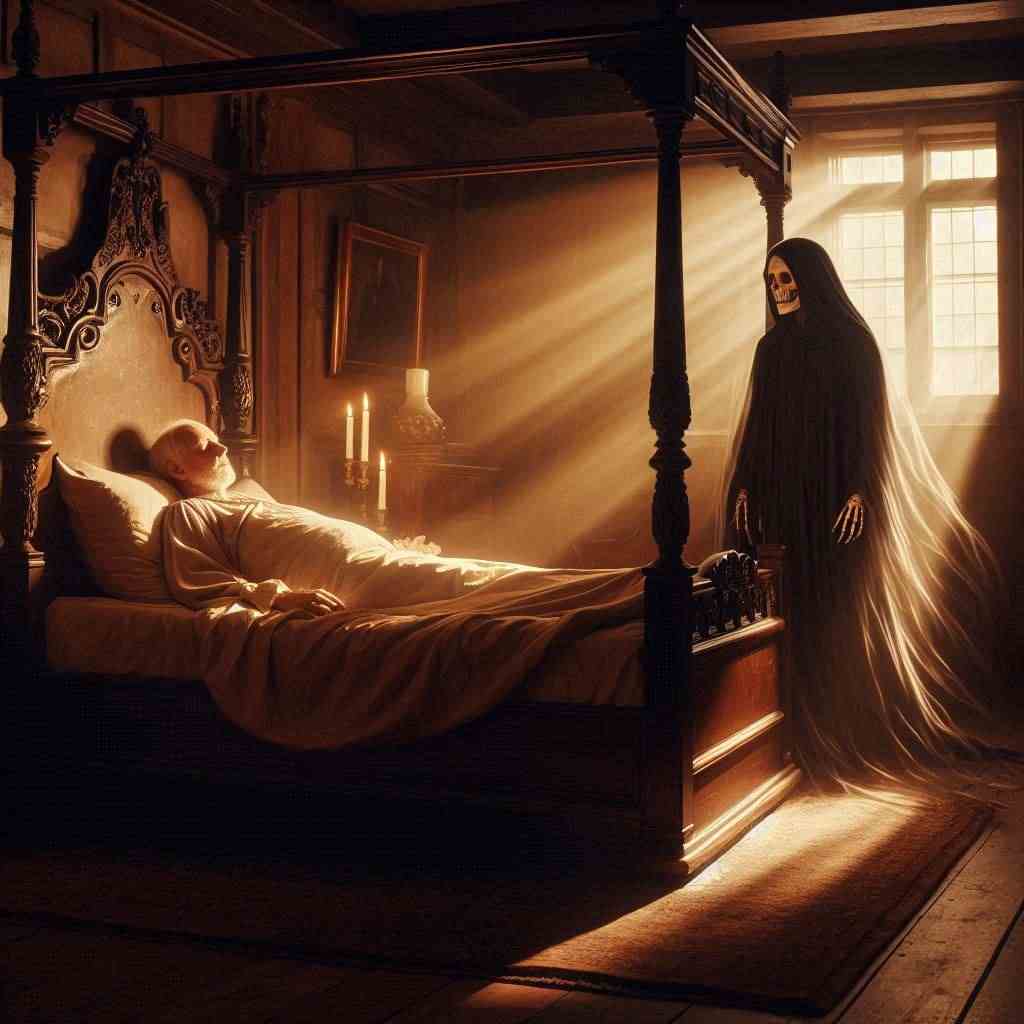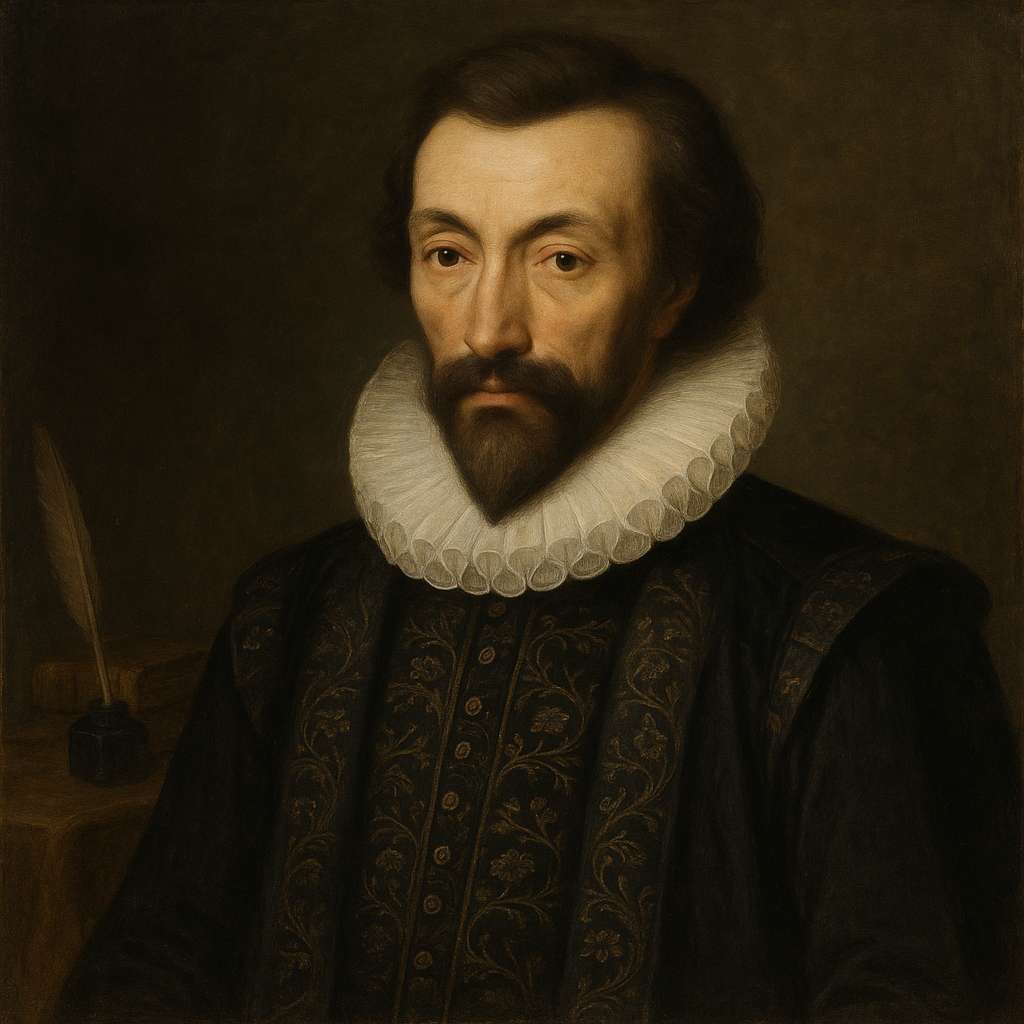Holy Sonnet 10: Death, Be Not Proud
John Donne
1572 to 1631

Death, be not proud, though some have called thee
Mighty and dreadful, for thou art not so;
For those whom thou think'st thou dost overthrow
Die not, poor Death, nor yet canst thou kill me.
From rest and sleep, which but thy pictures be,
Much pleasure; then from thee much more must flow,
And soonest our best men with thee do go,
Rest of their bones, and soul's delivery.
Thou art slave to fate, chance, kings, and desperate men,
And dost with poison, war, and sickness dwell,
And poppy or charms can make us sleep as well
And better than thy stroke; why swell'st thou then?
One short sleep past, we wake eternally
And death shall be no more; Death, thou shalt die.
John Donne's Holy Sonnet 10: Death, Be Not Proud
Introduction
John Donne's "Holy Sonnet 10," also known by its opening line "Death, be not proud," stands as a cornerstone of metaphysical poetry and a profound meditation on mortality. Composed in the early 17th century, this sonnet exemplifies Donne's masterful fusion of intellectual rigor, emotional depth, and spiritual contemplation. Through a close analysis of the poem's structure, language, and thematic concerns, we can unravel the complex tapestry of meanings woven into these fourteen lines, revealing Donne's innovative approach to the sonnet form and his unique perspective on death, immortality, and the human condition.
Structure and Form
Donne's choice of the sonnet form is deliberate and significant. The poem adheres to the traditional structure of an English or Shakespearean sonnet, consisting of three quatrains and a concluding couplet. This form typically facilitates a progression of thought, often presenting a problem or question in the octave (first eight lines) and offering a resolution or answer in the sestet (final six lines). However, Donne subverts this convention, using the structure to build a sustained argument against death's power, culminating in the powerful proclamation of the final couplet.
The rhyme scheme (ABBA ABBA CDDC EE) blends elements of both the English and Italian sonnet traditions, reflecting Donne's penchant for innovation and his ability to meld diverse influences into a cohesive whole. This hybrid form mirrors the poem's content, which reconciles Christian doctrine with classical and renaissance thought, creating a uniquely syncretic approach to the theme of mortality.
Rhetorical Strategy and Personification
Central to the poem's impact is Donne's bold personification of Death. By addressing Death directly, Donne employs the rhetorical device of apostrophe, immediately establishing a confrontational tone. This personification serves multiple purposes: it makes the abstract concept of death more tangible, allowing Donne to engage with it more directly, and it sets up the central conceit of the poem - that death can be reasoned with, challenged, and ultimately defeated.
The opening line, "Death, be not proud, though some have called thee / Mighty and dreadful, for thou art not so," immediately undermines death's perceived power. Donne acknowledges the common perception of death as formidable but swiftly dismisses it, setting the stage for his systematic deconstruction of death's authority.
Paradox and Irony
Donne's argument is built on a series of paradoxes and ironies that challenge conventional thinking about death. For instance, he asserts that those whom death "think'st thou dost overthrow / Die not, poor Death, nor yet canst thou kill me." This paradoxical statement suggests that death does not truly end life but is rather a transition to another state of being. The irony of addressing death as "poor Death" further diminishes its stature, turning the tables on the traditional power dynamic between humanity and mortality.
Another layer of irony emerges in the lines "From rest and sleep, which but thy pictures be, / Much pleasure; then from thee much more must flow." Here, Donne suggests that if sleep, a mere imitation of death, brings pleasure, then death itself must bring even greater joy. This counterintuitive reasoning exemplifies the metaphysical poets' love of paradox and their ability to find unexpected connections between seemingly disparate ideas.
Imagery and Metaphor
Donne's use of imagery and metaphor is characteristically rich and multifaceted. The comparison of death to "rest and sleep" is particularly evocative, drawing on familiar experiences to make the unknown more approachable. This metaphor also carries biblical resonance, echoing the Christian concept of death as a temporary state before resurrection.
The poet goes on to personify death as a slave, subject to "fate, chance, kings, and desperate men," and as a companion to "poison, war, and sickness." These images strip death of its autonomy and power, reducing it to a mere symptom or tool of other forces. The comparison of death's effects to those of "poppy or charms" further undermines its significance, suggesting that human inventions can replicate or even surpass death's power to induce unconsciousness.
Theological Underpinnings
While the poem's argumentative structure and use of paradox reflect Donne's metaphysical style, its core message is deeply rooted in Christian theology. The sonnet's final couplet, "One short sleep past, we wake eternally / And death shall be no more; Death, thou shalt die," encapsulates the Christian doctrine of resurrection and eternal life.
This theological foundation provides the ultimate refutation of death's power. By framing death as a temporary state - "One short sleep" - Donne aligns with the Christian belief in the soul's immortality and the promise of bodily resurrection. The final line, with its bold proclamation of death's own demise, echoes biblical passages such as 1 Corinthians 15:26: "The last enemy to be destroyed is death."
Language and Tone
Donne's language throughout the sonnet is characterized by its directness and forcefulness. The use of imperative verbs ("be not proud") and rhetorical questions ("why swell'st thou then?") creates a tone of confident challenge. This assertiveness is balanced by moments of almost playful mockery, as in the address to "poor Death," which serves to further undermine death's perceived might.
The poem's diction blends elevated, abstract terms ("fate," "eternally") with more colloquial expressions ("why swell'st thou then?"), creating a texture that is both intellectually rigorous and emotionally engaging. This linguistic variety reflects Donne's ability to bridge the gap between complex philosophical concepts and lived human experience.
Conclusion
"Death, be not proud" stands as a testament to John Donne's poetic genius and his ability to grapple with life's most profound questions. Through its innovative structure, powerful use of personification, paradox, and metaphor, and its deep engagement with Christian theology, the poem offers a multifaceted exploration of mortality that continues to resonate with readers centuries after its composition.
Donne's sonnet does more than simply deny death's power; it reframes our entire understanding of life and death. By positioning death as a transition rather than an end, and by asserting the ultimate triumph of eternal life, Donne offers a perspective that is at once comforting and challenging. The poem invites readers to confront their own mortality not with fear, but with the confident assertion that death itself is ultimately powerless in the face of eternity.
In its fusion of intellectual rigor, emotional depth, and spiritual insight, "Holy Sonnet 10" exemplifies the best of metaphysical poetry. It demonstrates Donne's ability to take on the most daunting of subjects with wit, eloquence, and profound humanity. As such, it continues to offer rich rewards for analysis and contemplation, standing as a timeless exploration of one of life's great mysteries.
This text was generated by AI and is for reference only. Learn more
Want to join the discussion? Reopen or create a unique username to comment. No personal details required!



Comments
No comments yet. Be the first to comment!